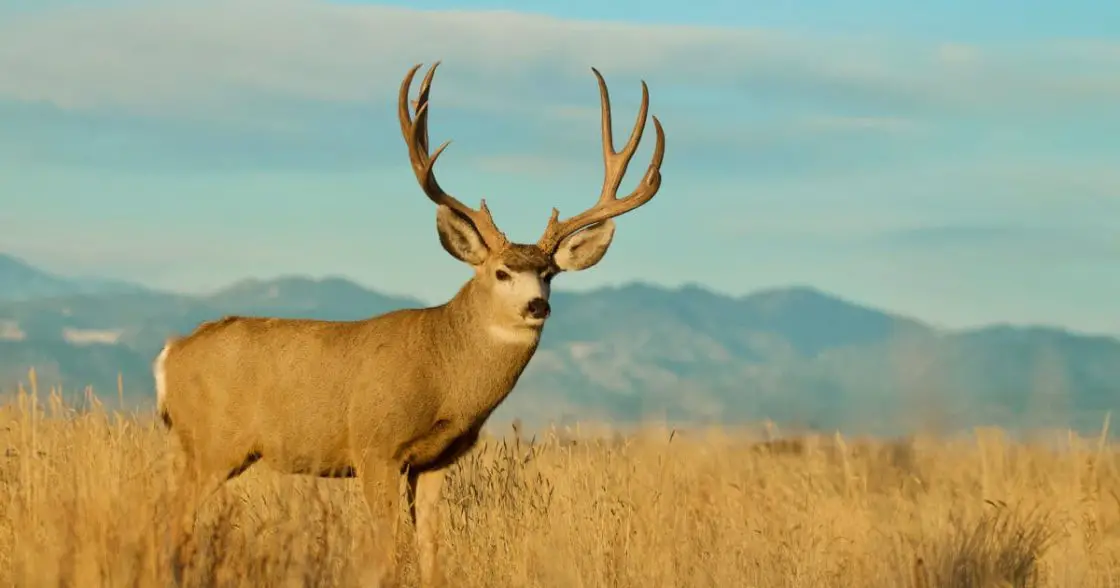Named for their large, mule-like ears, Mule Deer (Odocoileus hemionus) are indigenous to western North America and can be grouped into two subspecies of black-tailed deer.
Mule Deer are related to White Tailed Deer, a more widely distributed species native to North America, with key differences in range, ear shape, tail color, and antler configuration.
On this page we’ll share key details and information about Odocoileus hemionus so you can get to know the unique characteristics of Mule Deer.
What Size are Mule Deer?
- Head & Body Length – 100 to 190 cm
- Shoulder Height – 90 to 105 cm
- Tail Length – 10 to 25 cm
- Weight – 50 to 215 kg
What do Mule Deer Look Like?
The Mule Deer is so named because of its large prominent ears, which are reminiscent of those seen in mules. They are also sometimes known as the Burro Deer.
A large stocky species of deer, Odocoileus hemionus are generally larger in size than their close relative the White Tailed Deer.
Males, which are commonly called bucks, are typically larger and heavier than the females or does.
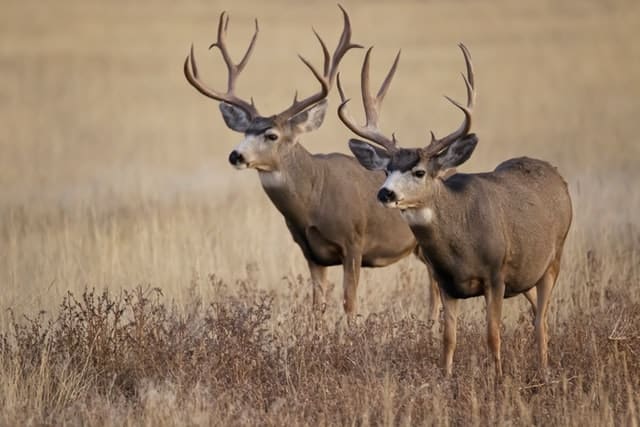
Coloration
The coat is a grey-ish to reddish-brown color in the summer, while in the winter months it much darker and is a brownish-grey.
The under parts are slightly lighter in color than the upper parts. The rump patch is lighter than the rest of the coat, usually a cream or white color. There is also a white patch of fur beneath the throat.
There is are dark mask like markings on the head, which run in a ‘V’ shape through the eyes. This is more distinct in the males than in the females.
Tail
The Mule Deer’s tail is different from that of the White-Tailed Deer’s.
Although it is quite long, it is not bushy. In color the tail is white, but has a black tip. The exact coloring of the tail can vary between individuals, with some animals having no black tip.
A well-known subspecies of the Mule Deer is the Black Tailed Deer, which (as its name suggests) has an all black tail.
Antlers
Mule Deer antlers are shed each year in spring, between January and April. Younger bucks lose them a little later than mature males. The antlers regrow quickly, reaching their full size within 150 days, at which point they shed their velvet.
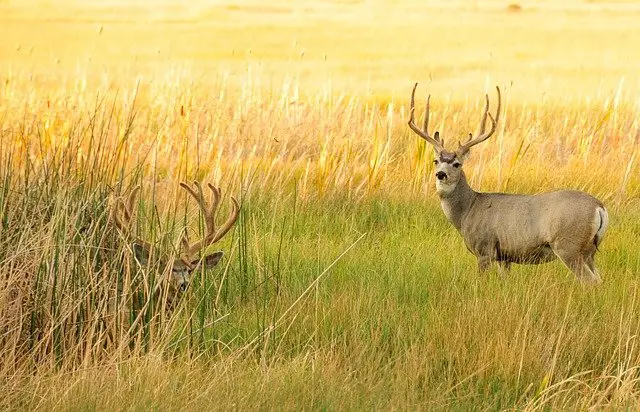
The antlers reach their full size when the buck is usually in there 3rd year. Mature bucks normally have a total of 8 tines, 4 on each antler, although it is common for bucks with fewer tines to be seen.
The antlers branch into equally sized forward and backwards forks. The antlers can be up to 78cm long, and have a breadth of over a metre.
Where do Mule Deer Live?
Next, let’s take a closer look at the habitat preferences and the range and distribution of Odocoileus hemionus.
Habitat
The Mule Deer is extremely adaptable in its habitat preferences. They will occupy nearly all types of habitat found among their distribution range.
That said, open and drier habitats are preferred.
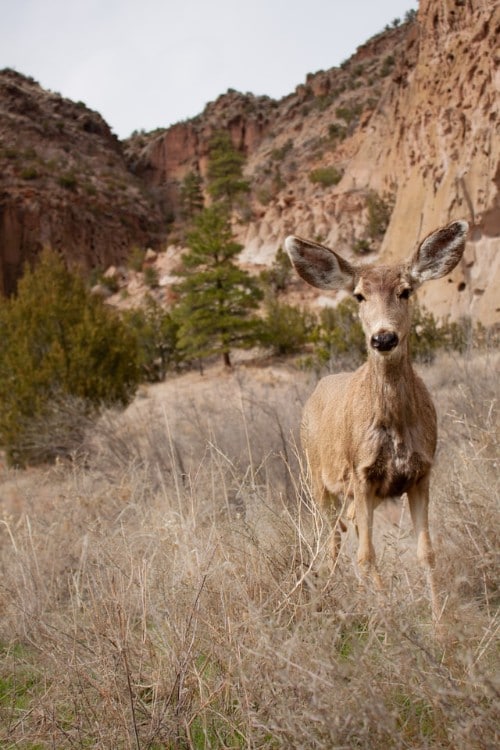
Unlike the White Tailed Deer, Mule Deer are happy in dry arid locations, and are found in semi-desert and desert areas. They also commonly inhabit hilly and mountainous areas.
Mule Deer will also live in woodland areas, but given the choice they prefer dry, open woodland and avoid denser thicker areas of forest some other types of deer prefer.
Range
The Mule Deer has a wide distribution range, and is found over large areas of the western parts of North America.
It can be found as far north as the Canadian Rockies, and its range extends as far south as the Mexican deserts.
Mule Deer are not at any conservation risk. They are often hunted by man for recreation.
Lifespan of the Odocoileus hemionus
In the wild they have a maximum lifespan of 10 years, but in captivity they have lived to be as old as 25 years. How long deer live is generally dictated by the environmental conditions of their surroundings.
What do Mule Deer Eat?
Mule Deer eat a variety of different foods, including twigs, shoots, grasses, leaves, seeds and berries.
They are a selective feeder, and they will choose the most succulent and nutritious shoots and grasses on which to feed.
A Mule Deer’s diet depends on the type of habitat in which they live. In more woodland areas a greater variety of food will be eaten than in desert areas, where they have fewer options.
Life Cycle & Reproduction in Mule Deer
Mating is polygamous, with Odocoileus hemionus bucks mating with a number of females each year.
The timing of reproduction and the birth of the young varies according to where the deer live. Northerly living Mule Deer have different reproductive cycles from more southerly living animals.
Generally the rut takes place around October to mid December. During the rutting period single males are seen in possession of small harems of females, with males competing vigorously for possession of the females.
Generally speaking the strongest and largest bucks have the most success at obtaining and holding on to harems.
After a 190 to 210 day long gestation period one or two fawns are born, usually in June or July.
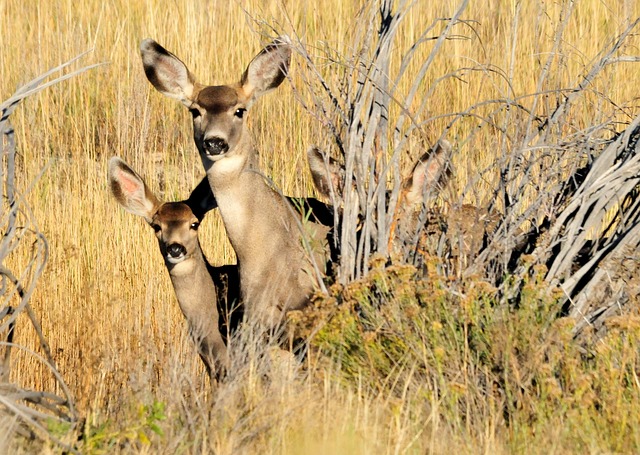
Younger does typically give birth to a single young, while older does normally have twin births.
Mule Deer fawns are left hidden in long vegetation for the first week of so of their life. After this time they are able to move around and begin to follow the mother doe. The fawns are spotted at birth, but these spots (a natural camouflage) fade at about 2 months of age.
At birth the young weigh on average 2.5 kg. Male fawns are heavier than females. The fawns are weaned at about 6 to 7 weeks of age. The young are sexually mature from about 18 months of age. Females normally conceive in their second year, however the bucks rarely get to mate before they are 3 or 4 years old due to fierce competition which favors strong, mature bucks.
Unique Behavior & Rituals
Mule Deer live in distinct home ranges, where they remain for much of the year. However, in some areas Mule Deer may move in distinct patterns at certain times of the year in a form of migration.
For example in colder areas they may spend the summer months in higher more exposed locations, only returning to lower more sheltered areas when winter and bad weather returns. In desert areas they may move around in response to rainfall patterns, looking for areas of new and fresh grazing.
Herds
The Mule Deer is a social animal, living in small herds of typically 3 or 4 animals.
Males and females live separately in separate herds, only coming together during the rutting season in late autumn.
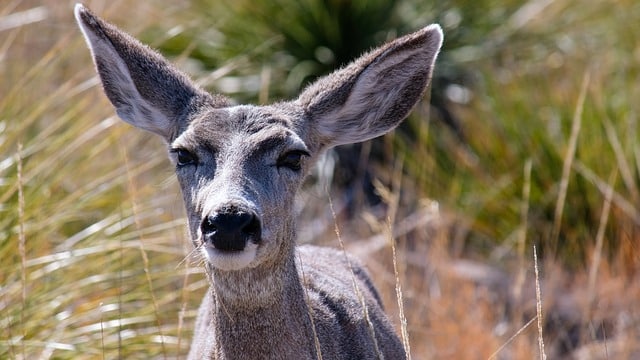
Within the small herds there is a strict dominance hierarchy. During the winter months Odocoileus hemionus gather in large herds, sometimes with hundreds of members. These large herds split up with the approaching spring, and for most of the rest of the year this type of deer lives in small groups.
Mule Deer are occasionally seen alone, and older males are more likely to become solitary in habits.
When Are Mule Deer Active?
Activity is concentrated in the early mornings and late evenings. During the hot middle parts of the day Mule Deer rest and remain inactive in a cool quiet location.
Predators & Evasion
The Mule Deer has a number of predators including the bear, puma, coyote and formerly the wolf. They are always alert to approaching danger. If a predator is spotted they will leap away in a distinct way.
Mule Deer are able to run at speeds of up to 45 kph.

